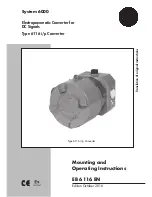
42
INS-2500 • 5403680 • REV C • 04/19
Nitrogen Generator Leak Detection System
Each Potter IntelliGen
™
Nitrogen Generator comes with an integrated Leak Detection System. The Leak Detection System uses
pressure decays to calculate the actual pressure loss in 24 hours, or the Leak Rate of the sprinkler system.
This Leak Rate is displayed on the IntelliGen
™
Display as “LR # PSI/24HR”. # is the number in PSI that is calculated.
Increases in the Leak Rate can cause excessive demand on the nitrogen generator. Excessive demand causes increased runtimes
on the unit. Increased runtimes increase the frequency of maintenance and repairs. In some cases, excessive Leak Rates can cause
catastrophic failures.
The Leak Detection System is designed as a rolling average over 1 week to ensure the presence of an actual leak. To reset the LR
number, reset the Maintenance Alert #2 under maintenance on the IntelliGen
™
display.
All Potter IntelliGen
™
Nitrogen Systems are designed to run approximately 1,000 operating hours in a typical year.
This translates to a maximum pressure loss of 6 PSI in 24 hours. This is the default Leak Rate Warning Set Point. If the actual
Leak Rate of the sprinkler system is greater than that value, a maintenance alert or a trouble will display on the nitrogen generator.
The Leak Rate Warning Set Point in the Potter IntelliGen
™
Nitrogen Generator is a user adjustable set point for when a
maintenance or trouble alert is activated. It will give a preemptive warning that the system Leak Rates have increased above the
acceptable level.
This Leak Rate Warning Set Point can be set from 1 PSI up to 36 PSI per 24 hours.
•
NFPA 13 allows a leak rate of 1.5 PSI loss per 24 hours for new systems.
•
NFPA 25 allows a leak rate of 36 PSI loss per 24 hours for existing systems.
Example: At a 6 PSI loss per 24 hour leak rate, the unit will run approximately 1,000 hours per year. At a 36 PSI loss per 24
hour leak rate, the unit will run approximately 6,000 hours per year. That means, at a 6 PSI leak rate, the air compressor will be
operating 11% of the year, compared to a 36 PSI leak rate, where the air compressor will be operating 70% of the year.
Increases in Leak Rates will cause more maintenance and possible failures.
















































